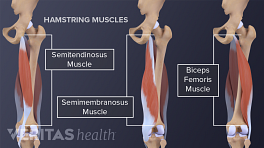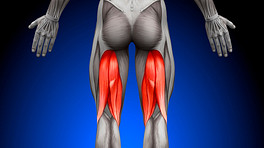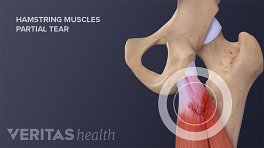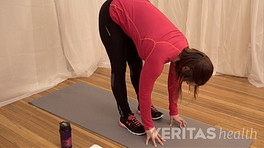Chronic high (proximal) hamstring tendinopathies can be difficult to manage, as they are less likely to respond to conservative measures, such as soft-tissue mobilization, flexibility, and strength training. 1 Lempainen L, Sarimo J, Mattila K, Vaittinen S, Orava S. Proximal hamstring tendinopathy: results of surgical management and histopathologic findings. Am J Sports Med 2009;37:727-34. , 2 Puranen J, Orava S. The hamstring syndrome--a new gluteal sciatica. Ann Chir Gynaecol 1991;80:212-4. , 3 Fredericson M, Moore W, Guillet M, Beaulieu C. High Hamstring Tendinopathy in Runners: Meeting the Challenges of Diagnosis, Treatment, and Rehabiliation. Phys Sports Med 2005;33:32-43. , 4 Zissen M, Wallace G, Stevens K, Fredericson M, Beaulieu C. High hamstring tendinopathy: MRI and ultrasound imaging and therapeutic efficacy of percutaneous corticosteroid injection. AJR Am J Roentgenol 2010;195:993-8. Chronic tendinopathies often result in a prolonged recovery of 3 to 6 months, with many patients having residual pain and discomfort. 1 Lempainen L, Sarimo J, Mattila K, Vaittinen S, Orava S. Proximal hamstring tendinopathy: results of surgical management and histopathologic findings. Am J Sports Med 2009;37:727-34. , 2 Puranen J, Orava S. The hamstring syndrome--a new gluteal sciatica. Ann Chir Gynaecol 1991;80:212-4. , 3 Fredericson M, Moore W, Guillet M, Beaulieu C. High Hamstring Tendinopathy in Runners: Meeting the Challenges of Diagnosis, Treatment, and Rehabiliation. Phys Sports Med 2005;33:32-43. , 4 Zissen M, Wallace G, Stevens K, Fredericson M, Beaulieu C. High hamstring tendinopathy: MRI and ultrasound imaging and therapeutic efficacy of percutaneous corticosteroid injection. AJR Am J Roentgenol 2010;195:993-8. , 5 Sarimo J, Lempainen L, Mattila K, Orava S. Complete proximal hamstring avulsions: a series of 41 patients with operative treatment. Am J Sports Med 2008;36:1110-5. However, proper recognition and management of injuries has been shown to result in an improved return to sport and a decreased rate of re-injury. 6 Askling C, Tengvar M, Tarassova O, Thorstensson A. Acute hamstring injuries in Swedish elite sprinters and jumpers: a prospective randomised controlled clinical trial comparing two rehabilitation protocols. Br J Sports Med 2014;48:532-9. , 7 Petersen J, Thorborg K, Nielsen M, Budtz-Jørgensen E, Hölmich P. Preventive effect of eccentric training on acute hamstring injuries in men's soccer: a cluster-randomized controlled trial. Am J Sports Med 2011;39:2296-303. , 8 Arnason A, Andersen T, Holme I, Engebretsen L, Bahr R. Prevention of hamstring strains in elite soccer: an intervention study. Scand J Med Sci Sports 2008;18:40-8. , 9 Folsom G, Larson C. Surgical treatment of acute versus chronic complete proximal hamstring ruptures: results of a new allograft technique for chronic reconstructions. Am J Sports Med 2008;36:104-9. , 10 Mason D, Dickens V, Vail A. Rehabilitation for hamstring injuries. Cochrane Database Syst Rev 2012;12:CD004575.
In This Article:
- Chronic High (Proximal) Hamstring Tendinopathy
- Symptoms of Chronic High (Proximal) Hamstring Tendinopathy
- High (Proximal) Hamstring Tendinopathy Risk Factors
- Diagnosing Chronic High (Proximal) Hamstring Tendinopathy
- Treatments for Chronic High Hamstring Tendinopathy
- Minimally Invasive Treatments for Chronic High Hamstring Tendinopathy
- Surgery for Chronic High (Proximal) Hamstring Tendinopathy
Non-Invasive (Conservative) Management
Non-invasive treatments attempt to promote healing and reduce the risk factors for further injury. The most common non-invasive (conservative) treatments are described below. Typically patients will participate in treatment under the guidance of a licensed physical therapist.
Rest. Resting will help reduce pain and give the tendon(s) a chance to recover. This often will require accurate determination of the offensive activity and cessation of that activity. Patients may need to take time off from training, cross-train with alternative activities, or significantly cut back on training, in order to allow the injured tendon to heal.
Ice and heat. Icing (including cold packs, ice baths, and ice massage) may be recommended to reduce pain and inflammation. Typically ice packs applied for 10 to 20 minutes following activity and/or every 2 to 4 hours throughout the day. Patients may also use heat and massage to help loosen fibrotic or scarred tissue, followed by stretching. Patients may use alternating heat with ice. Caution should be taken to avoid cold injuries and heat injuries. Patients should consult a qualified medical professional for further information and guidance.
See The P.R.I.C.E. Protocol Principles
Stretching. Given that lack of flexibility is a risk factor for chronic high hamstring tendinopathy, it seems prudent to develop a program of stretching for tight/inflexible hamstring tendons and muscles. A patient, with the guidance of a therapist, may be taught stretching exercises to improve flexibility and range of motion. The patient should be aware that this can take time, sometimes months, to notice improvement.
Strengthening. Guided strengthening of weak muscles under the guidance of a qualified medical professional or physical therapist is recommended for conservative management. Eccentric hamstring strengthening has been shown in the literature to be preventative of new and recurrent hamstring injuries in soccer players. 6 Askling C, Tengvar M, Tarassova O, Thorstensson A. Acute hamstring injuries in Swedish elite sprinters and jumpers: a prospective randomised controlled clinical trial comparing two rehabilitation protocols. Br J Sports Med 2014;48:532-9. , 7 Petersen J, Thorborg K, Nielsen M, Budtz-Jørgensen E, Hölmich P. Preventive effect of eccentric training on acute hamstring injuries in men's soccer: a cluster-randomized controlled trial. Am J Sports Med 2011;39:2296-303. , 8 Arnason A, Andersen T, Holme I, Engebretsen L, Bahr R. Prevention of hamstring strains in elite soccer: an intervention study. Scand J Med Sci Sports 2008;18:40-8. , 11 Brooks J, Fuller C, Kemp S, Reddin D. Incidence, risk, and prevention of hamstring muscle injuries in professional rugby union. Am J Sports Med 2006;34:1297-306. , 12 Heiderscheit B, Sherry M, Silder A, Chumanov E, Thelen D. Hamstring strain injuries: recommendations for diagnosis, rehabilitation, and injury prevention. J Orthop Sports Phys Ther 2010;40:67-81. There is evidence that incorporation of eccentrics into preseason and in-season training may decrease the occurrence of hamstring injuries and prevent recurrent hamstring injuries. 6 Askling C, Tengvar M, Tarassova O, Thorstensson A. Acute hamstring injuries in Swedish elite sprinters and jumpers: a prospective randomised controlled clinical trial comparing two rehabilitation protocols. Br J Sports Med 2014;48:532-9. , 7 Petersen J, Thorborg K, Nielsen M, Budtz-Jørgensen E, Hölmich P. Preventive effect of eccentric training on acute hamstring injuries in men's soccer: a cluster-randomized controlled trial. Am J Sports Med 2011;39:2296-303. , 8 Arnason A, Andersen T, Holme I, Engebretsen L, Bahr R. Prevention of hamstring strains in elite soccer: an intervention study. Scand J Med Sci Sports 2008;18:40-8. , 11 Brooks J, Fuller C, Kemp S, Reddin D. Incidence, risk, and prevention of hamstring muscle injuries in professional rugby union. Am J Sports Med 2006;34:1297-306. , 12 Heiderscheit B, Sherry M, Silder A, Chumanov E, Thelen D. Hamstring strain injuries: recommendations for diagnosis, rehabilitation, and injury prevention. J Orthop Sports Phys Ther 2010;40:67-81. However, the use of eccentric exercises in the management of tendinopathy is controversial. There have been several studies showing positive effects and some showing no beneficial effects. 13 Croisier J, Foidart-Dessalle M, Tinant F, Crielaard J, Forthomme B. An isokinetic eccentric programme for the management of chronic lateral epicondylar tendinopathy. Br J Sports Med. 2007;41. , 14 Manias P, Stasinopoulus D. A controlled clinical pilot trial to study the effectiveness of ice as a supplement to the exercise programme for the management of lateral elbow tendinopathy. Br J Sports Med. 2006;40 , 15 Tyler T, Nicholas S, Schmitt B, Mullaney M, Hogan D. Clinical outcomes of the addition of eccentrics for rehabilitation of previously failed treatments of golfers elbow. Int J Sports Phys Ther. 2014;9. , 16 Tyler T, Thomas G, Nicholas S, McHugh M. Addition of isolated wrist extensor eccentric exercise to standard treatment for chronic lateral epicondylosis: a prospective randomized trial. J Shoulder Elbow Surg. 2010;19 The patient should be aware that hamstring eccentric exercises can be quite painful, especially in the first few weeks, and have been shown to take up to 12 weeks to work. 6 Askling C, Tengvar M, Tarassova O, Thorstensson A. Acute hamstring injuries in Swedish elite sprinters and jumpers: a prospective randomised controlled clinical trial comparing two rehabilitation protocols. Br J Sports Med 2014;48:532-9. , 7 Petersen J, Thorborg K, Nielsen M, Budtz-Jørgensen E, Hölmich P. Preventive effect of eccentric training on acute hamstring injuries in men's soccer: a cluster-randomized controlled trial. Am J Sports Med 2011;39:2296-303. , 8 Arnason A, Andersen T, Holme I, Engebretsen L, Bahr R. Prevention of hamstring strains in elite soccer: an intervention study. Scand J Med Sci Sports 2008;18:40-8. It is important that eccentric strengthening is done with proper technique. A licensed physical therapist can teach appropriate form and make other recommendations, such as the appropriate repetitions per set.
Non-steroidal anti-inflammatory drugs (NSAIDs). Aspirin, ibuprofen (Motrin, Advil), naproxen (Aleve, Naprosyn), and other NSAIDs may help alleviate pain and help reduce inflammation. Patients should follow prescribed dosages and discontinue/consult a medical professional if there are adverse reactions, such as gastrointestinal bleeding or stomach irritation.
Extracorporeal shock-wave therapy (ESWT). This therapy is an outpatient procedure performed in a doctor’s office. The doctor or therapist applies a probe to the skin over the affected area, and the probe delivers shock waves via an electrical charge. This can be quite painful, especially in the first few days following treatment. The generally accepted theory is that the shock waves may promote healing by improving blood flow and breaking up fibrotic scar tissue. 17 Buchbinder R, Green S, Youd K, Assendelft W, Barnsley L, Smidt N. Shockwaves for lateral elbow pain. The Cochrane Library. 2006;4. , 18 Radwan Y, ElSobhi G, Badawy W, Reda A, Khalid S. Resistant tennis elbow: shock-wave therapy versus percutaneous tenotomy. Int Orthop. 2008;32. , 19 Lee S, Kang S, Park N, Lee C, Song H, Sohn M, et al. Effectiveness of initial extracorporeal shock wave therapy on the newly diagnosed lateral or medial epicondylitis. Ann Rehabil Med. 2012;36
A non-invasive treatment program for hamstring tendinopathy can last 3 to 6 months. Patients that fail to improve within this time period may consider alternative treatment options, such as ultrasound guided corticosteroid injections, ultrasound-guided needle tenotomy, ultrasound-guided platelet-rich plasma (PRP) injections, or ultrasound-guided percutaneous (through the skin) ultrasonic tenotomy.
- 1 Lempainen L, Sarimo J, Mattila K, Vaittinen S, Orava S. Proximal hamstring tendinopathy: results of surgical management and histopathologic findings. Am J Sports Med 2009;37:727-34.
- 2 Puranen J, Orava S. The hamstring syndrome--a new gluteal sciatica. Ann Chir Gynaecol 1991;80:212-4.
- 3 Fredericson M, Moore W, Guillet M, Beaulieu C. High Hamstring Tendinopathy in Runners: Meeting the Challenges of Diagnosis, Treatment, and Rehabiliation. Phys Sports Med 2005;33:32-43.
- 4 Zissen M, Wallace G, Stevens K, Fredericson M, Beaulieu C. High hamstring tendinopathy: MRI and ultrasound imaging and therapeutic efficacy of percutaneous corticosteroid injection. AJR Am J Roentgenol 2010;195:993-8.
- 5 Sarimo J, Lempainen L, Mattila K, Orava S. Complete proximal hamstring avulsions: a series of 41 patients with operative treatment. Am J Sports Med 2008;36:1110-5.
- 6 Askling C, Tengvar M, Tarassova O, Thorstensson A. Acute hamstring injuries in Swedish elite sprinters and jumpers: a prospective randomised controlled clinical trial comparing two rehabilitation protocols. Br J Sports Med 2014;48:532-9.
- 7 Petersen J, Thorborg K, Nielsen M, Budtz-Jørgensen E, Hölmich P. Preventive effect of eccentric training on acute hamstring injuries in men's soccer: a cluster-randomized controlled trial. Am J Sports Med 2011;39:2296-303.
- 8 Arnason A, Andersen T, Holme I, Engebretsen L, Bahr R. Prevention of hamstring strains in elite soccer: an intervention study. Scand J Med Sci Sports 2008;18:40-8.
- 9 Folsom G, Larson C. Surgical treatment of acute versus chronic complete proximal hamstring ruptures: results of a new allograft technique for chronic reconstructions. Am J Sports Med 2008;36:104-9.
- 10 Mason D, Dickens V, Vail A. Rehabilitation for hamstring injuries. Cochrane Database Syst Rev 2012;12:CD004575.
- 11 Brooks J, Fuller C, Kemp S, Reddin D. Incidence, risk, and prevention of hamstring muscle injuries in professional rugby union. Am J Sports Med 2006;34:1297-306.
- 12 Heiderscheit B, Sherry M, Silder A, Chumanov E, Thelen D. Hamstring strain injuries: recommendations for diagnosis, rehabilitation, and injury prevention. J Orthop Sports Phys Ther 2010;40:67-81.
- 13 Croisier J, Foidart-Dessalle M, Tinant F, Crielaard J, Forthomme B. An isokinetic eccentric programme for the management of chronic lateral epicondylar tendinopathy. Br J Sports Med. 2007;41.
- 14 Manias P, Stasinopoulus D. A controlled clinical pilot trial to study the effectiveness of ice as a supplement to the exercise programme for the management of lateral elbow tendinopathy. Br J Sports Med. 2006;40
- 15 Tyler T, Nicholas S, Schmitt B, Mullaney M, Hogan D. Clinical outcomes of the addition of eccentrics for rehabilitation of previously failed treatments of golfers elbow. Int J Sports Phys Ther. 2014;9.
- 16 Tyler T, Thomas G, Nicholas S, McHugh M. Addition of isolated wrist extensor eccentric exercise to standard treatment for chronic lateral epicondylosis: a prospective randomized trial. J Shoulder Elbow Surg. 2010;19
- 17 Buchbinder R, Green S, Youd K, Assendelft W, Barnsley L, Smidt N. Shockwaves for lateral elbow pain. The Cochrane Library. 2006;4.
- 18 Radwan Y, ElSobhi G, Badawy W, Reda A, Khalid S. Resistant tennis elbow: shock-wave therapy versus percutaneous tenotomy. Int Orthop. 2008;32.
- 19 Lee S, Kang S, Park N, Lee C, Song H, Sohn M, et al. Effectiveness of initial extracorporeal shock wave therapy on the newly diagnosed lateral or medial epicondylitis. Ann Rehabil Med. 2012;36









